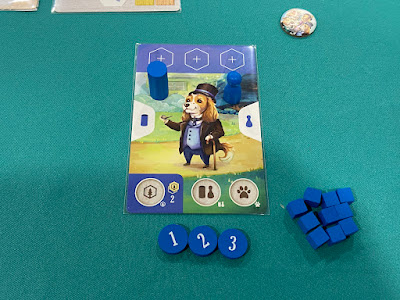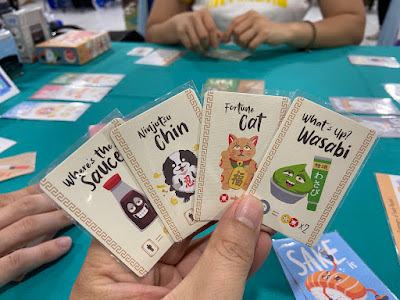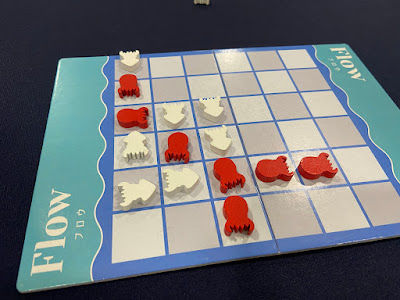This time I'll introduce some games from Singapore and Japan. The Japanese games were actually introduced by Tom from Taiwan. He regularly attends conventions in Taiwan, China and Japan, and he helps promote interesting games he finds. No Taiwanese games in this post, but I will write about some Taiwanese games soon.
River Woods is a title from Singapore designed by my friend Geoffrey Chia of Good Spirit Games. This is his first time publishing a Euro style game, and this has been a labour of love.
This is one of the possible game setups called the Flower. You have hex tiles of different terrain types. As you play, you will add terrain tiles and the play area will expand.
This is your main character. During the game you may recruit up to 2 assistants. The three disks numbered 1 to 3 are your action disks. The numbers mean action points. Every round you will spend them all. There are three action types in the game, as shown at the bottom of your character card. The first icon on the left means adding terrain tiles. You must do this at least once during a round. The second icon means recruiting assistants. The third icon means movement.
In this game you complete missions to score points. There are publicly known missions you compete for. You also have secret missions in hand. When you complete a secret mission you must play the card so that others can also try to complete it. However a mission that has been completed will become harder to complete for the next player. The point value will also degrade.
That mission at the bottom right requires you to have three specific resources in hand. When you move your pieces around the play area you can collect resources. You may keep at most three. If you get a fourth resource, you must discard one of the three in hand.
Another mission type requires your pieces to be standing on specific terrain types of certain sizes.
Assistants you recruit have various abilities. They also allow you to collect specific resources. Assistants are your only way to collect resources. Expect to fire and recruit new assistants during the game, especially if you intend to complete the missions related to resources.
This is mostly an open information game. There is no direct attacking, but this is a highly competitive game because space is limited and blocking happens all the time. You need to fight for the terrain tiles you need.
This is another game from Geoffrey, Nightmares of Sushi.
This is a simultaneous action selection game. Everyone has the same set of sushi cards and also the same set of special ability cards. Every round you must offer a sushi card at your shop face-down, and you may play a special ability card. Before the sushi is revealed, everyone must decide which shop to visit. You may visit anyone else's shop or a neutral shop, but you may not visit your own shop. Only if no one buys your sushi, then you must eat your own sushi.
Some sushi are good and some are bad. The good ones give you points while the bad ones deduct points.
These are some of the special ability cards. Some of these only take effect if you are the only player to play it. If two or more players play the same card, they are wasted. So this is a game about trying to guess your opponents' intentions. You can discuss, negotiate and lie. You can even try to collaborate. However this is not a cooperative game. You try to work out what people are thinking. Sometimes you try to mislead them too. Since this is a simultaneous action selection game, if you can guess your opponents' plans correctly, you will have a huge advantage.
When you eat good sushi, you score points using the board on the left. If you eat bad sushi, you "score points" too but using the board on the right. Your final score is your good sushi score minus your bad sushi score. However if you get so good at eating bad sushi that you reach 10 bad sushi points, you win immediately because you are legend.
Towards late game you will have more and more information. You would have seen which cards the other players have used, and this helps you in deciding which card to play next and which shop to visit. At the start of the game everyone removes one card from their sushi deck. So even if everyone has perfect memory, when you get to the final round, there are still two possibilities and you cannot be 100% sure what cards your opponents have left.
TOPPEN is a 2-player abstract game from Japan. The theme is mountain-climbing.
At the start of the game you lay out the tiles to form the play area. On your turn you move one of your pieces one step. You can stack it on top of an adjacent piece or stack. You can move it to an empty space. You only move one piece. If it is the top piece of a stack, the rest of the stack stay in place. You must never break the play area into two. The play area will gradually shrink.
At this point the green/yellow player has only one piece he can move. If you can't make a move, the game still goes on. Your opponent makes multiple moves in a row. The game ends when there is only one stack left. Whoever's piece is on top wins.
You need a hand in the photo to get a sense of how big the tiles are.
The winner is the green/yellow player
Flow is a game from Japan, by Jun Matsuoka (DICE Board Game Club). This too is a 2-player abstract game.
You goal is to form a straight line with four of your pieces. It can be vertical, horizontal or diagonal. On your turn you must play a piece, and then you may move any one of your pieces. Moving your piece means pushing it in the direction it is pointing at. If any other pieces are in the way, all of them will be pushed one step away. You may be pushing one whole row of pieces. If any piece you are going to push is blocked by the edge of the board, then you can't push.
When I played, I couldn't get past the instinct of moving the piece I had just placed. The piece you move is not restricted to the one you have just played. There are many possibilities when you consider other existing pieces. You should use both an existing piece and the new piece to help you change the situation on the board and ultimately to win.
Wire is from the same designer and publisher, and it is also a 2-player abstract game.
Two of the edges of the game board are blue, and the other two are red. One player plays blue, and the other plays red. To win, you must use your pieces to connect the two edges of your colour. On your turn, you either place a piece, or you rotate one of your pieces by 90 degrees.
While you are trying to complete the connection, you must also think about blocking your opponent. The situation you see in the photo above can only happen in beginner games. Blue allowed red to complete the connection too easily.
I was red and I won, but this was just a demo game and I'm positive the teacher had let me win.
























2 comments:
Wire reminds me of an older game called Twixt, which had slightly different geometry but which did not allow you to rotate a piece once placed.
Aaah yes, I have seen photos of Twixt but I have not played it myself.
Post a Comment